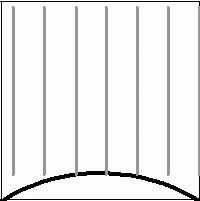2.1
The case for absolute speed
Let’s
start
by addressing one issue about Special Relativity. If
two
objects are moving with respect to each other at
sufficient speed,
Special Relativity states that they perceive each other as
running on
slower clock than their own, and to experience some length
contraction
in the direction of motion. Lets take a closer look
at a real
life example to better illustrate the case. An
estimated 10,000
muons fall to every square meter of Earth’s surface every
minute.
Muons are created when cosmic rays strike molecules in the
upper
atmosphere and they have a very short life, about 2.2
microsec.
See Figure 5 below for an illustration
Figure 5: Special Relativity Earth/muon perspective
Because
muons
are
traveling very fast, near the speed of light, a muon
experiences time
dilation effects that allow it to travel much farther
than the 660
meters that light would travel in 2.2 microseconds,
muons actually make
it to Earth’s surface and well below because they
interact very little
with other matter. That means that the life of a
muon is
lengthened to about 0.5 milliseconds. From the
muon’s
perspective, because Earth is moving at nearly the
speed of light,
Earth looks like a flat pancake and Earth’s atmosphere
is only a few
hundred meters; a muon’s life is long enough for it to
go through
before it decays. These are logical explanations
from their own
perspective, the muon’s and Earth’s as to how events
unfold. Both perspectives are assumed to
be true, and it is
only an issue of reality being relative. Now
let’s introduce a
third element to this event. This element is in
the form of a
clock, let’s say a pulsar some 1000 light-years
away. Let’s have
this pulsar send out a pulse every 0.1
milliseconds. A real
pulsar with a period that short could not be found,
but let’s assume
that one exists. Let’s also have the muon have a
motion that is
perpendicular to the direction of the pulsar, so as to
have common
Doppler with Earth. (See animation below)

Muon
falling to
Earth with 0.1 ms pulsar
Now, from the Earth’s perspective, as the
muon falls through the atmosphere, an Earth observer
will see 5 pulses
from the pulsar, before the moun decays 0.5 ms
later. From the
muon’s perspective, as it goes through Earth’s
atmosphere, it will also
see 5 pulses in its 2.2 μs life. While Earth is
seeing 0.1 ms
pulses, the muon will see very short pulses, of only
0.44 μs
long. It is clear the Earth’s clock and the
muon’s clock are not
running at the same rate. They are experiencing
different time
dilations. And since time dilations are due to
their speed, we
have to ask: With respect to what? Let’s
have another muon,
180º from the first on the other side of Earth, also
moving near
the speed of light and with about the same life as the
first. The
second muon’s path will also be as long as the first,
and will see
about the same number of pulses as the first.
There has to be a
speed along the axis formed by the two muons, for
which the period of
the pulsar will be a maximum. This leads to the
concept of
absolute speed. A rocket moving with constant
acceleration along
the axis formed by the two muons will also see shorter
and shorter
periods for the pulsar as it approaches the same frame
of reference as
one of the two muons. This is a different type
of blue shifting
that is neither Doppler nor gravitational. And
also pulsars on
all sides perpendicular to the motion will be blue
shifted and their
apparent position will also change in the direction of
motion.
More
evidence
for absolute speed can be found at particle
accelerators. Consider two decaying particles
like a pair of
muons (twins). One muon stays stationary and the
other one is
traveling near the speed of light inside the
accelerator (circular or
linear makes no difference). It is the one
moving fast with
respect to the accelerator and the rest of the planet
the one that
experiences a longer life. This is an experimental
proof to the twin
paradox. If we consider the motion of Earth
around the sun, and
the sun’s motion in the galaxy they are all very small
compared to the
speed of light, we can say we are almost stationary in
space.
Based on this short discussion and for the rest of
this paper, it will
be assumed that the concept of absolute speed is
valid. This
concept is not incompatible with other aspects of
Special Relativity,
nor does it mean that there are fixed locations in
space as will be
discussed in later sections.
